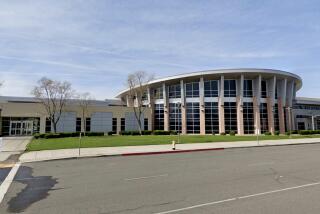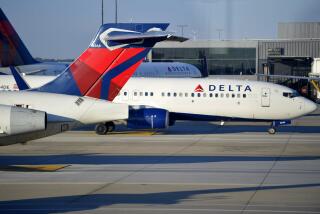Pilot, Co-Pilot in Fatal Crash Say Flaps Were Deployed
IRVING, Tex. — The pilot and co-pilot of a Delta Air Lines jetliner that crashed on takeoff here Aug. 31 both testified Tuesday that the plane’s wing flaps were deployed properly despite growing evidence to the contrary.
Capt. Larry L. Davis and First Officer Carey W. Kirkland Jr. both said they were “certain” that Kirkland had moved the lever that shifts the flaps into the correct position for takeoff, but both men admitted that they did not specifically recall doing it, and were relying instead on their belief that correct cockpit procedures were followed.
Davis, Kirkland and Flight Engineer Steven M. Judd defended these cockpit procedures, disputing crash investigators’ suggestions that the cockpit discipline was sloppy and at variance with established federal and airline procedures.
Crash Killed 14
The three men were the first witnesses at what is expected to be a weeklong hearing by the National Transportation Safety Board into the crash at Dallas-Ft. Worth International Airport that killed 14 of the 108 aboard the Boeing 727 jetliner bound for Salt Lake City.
The NTSB continues to stress that it will be some time before it determines what caused the crash, but attention has focused in recent weeks on the possibility that the plane’s flaps and slats were not deployed properly by the cockpit crew.
Flaps are metal surfaces on the trailing edge of the wing and slats are surfaces on the leading edge. Both normally are extended in the “down” position to give the plane the extra lift needed to take off.
Recording Recovered
A cockpit voice recording recovered from the wreckage of Flight 1141 showed that Judd had properly called off flap deployment as he ran down a preflight checklist and Kirkland had responded that the flaps were correctly placed.
All three men said they subsequently checked their instruments to confirm that the flaps were in place. However--as in the case of the deployment lever--Davis and Kirkland admitted Tuesday that they do not specifically remember looking at their instruments. Judd said only that he “did not deviate” from the normal pattern he uses to scan his control board before takeoff.
Contradicting the men’s beliefs is a growing body of evidence:
--After the crash, the flaps were found in the fully retracted position. The slats, torn from their moorings on impact, were in a semi-retracted position.
--NTSB investigators checking the wreckage of the cockpit found the flap deployment handle in the fully retracted position.
--”Clicks” heard on the cockpit voice recording, thought at first to be the sound of the flap deployment lever moving into the “down” position, do not match the sounds recorded when the NTSB attempted to re-create the situation.
--During the 21 seconds the plane flew before it slammed back into the ground, it was moving at about 168 knots, more than enough to remain airborne if the flaps and slats had been deployed properly, according to NTSB sources.
Cites ‘Variances’
Jeff Gorney, an NTSB aerospace engineer who led the questioning at Tuesday’s hearing, cited a number of “variances” between the procedures followed in the cockpit of Flight 1141 and the procedures spelled out in Delta and Federal Aviation Administration manuals.
Among the deviations cited by Gorney were Davis’ failure to call for the checklist orally, his failure to perform a takeoff briefing on the runway and the fact that a flight attendant was permitted to chat with the cockpit crew for several minutes while the plane was taxiing before takeoff.
Davis defended his cockpit procedures, saying he called for the checklist through a hand signal, the information from the takeoff briefing had been given to the cockpit crew at the gate and the conversations with the flight attendant did not interfere with any “critical” operations in the cockpit.
“Are you satisfied with the cockpit discipline that day?” Gorney asked him.
“Yes I am,” Davis replied. “I think my crew went above and beyond.”
Defend Procedures
Both Kirkland and Judd defended the cockpit procedures under Davis’ command.
“I thought he was a very professional pilot,” Kirkland said. “His procedures didn’t strike me as anything out of the ordinary.”
“Davis is an excellent pilot,” Judd said. “An ideal pilot.”
The three members of the cockpit crew were among 94 who survived the crash. All three were knocked unconscious and injured; all three have since recovered from their injuries.
Kirkland said he has little recollection of the moments before the crash, and Davis said he “had a handful of airplane” and was too busy fighting the controls to observe much of what else was going on.
Abrupt Roll to Right
Judd said that after an apparently normal takeoff roll and liftoff, he felt “an abrupt roll to the right, like I had never seen before. The right wing may have actually made contact (with the ground).
“I looked back over at the captain, kind of interested at what his response would be,” Judd said. “I clearly saw him doing everything he could to fly the airplane.”
Judd said he heard the plane’s “stick-shaker,” an alarm system that sounds a warning while shaking the pilot’s and co-pilot’s control yokes to warn them that the plane is going into a stall.
He also said he heard someone call out “engine failure.” The NTSB said that shout, by Kirkland, apparently was in response to so-called “compressor stalls” in one or more of the engines. These backfires, usually caused by an uneven airflow into engines when a plane is in a contorted attitude, apparently did not contribute in any major way to the crash, according to NTSB sources.
“I recall the impact (and) hearing some screams,” Judd said. “I remember the feeling that I wasn’t going to make it.”
More to Read
Sign up for Essential California
The most important California stories and recommendations in your inbox every morning.
You may occasionally receive promotional content from the Los Angeles Times.










